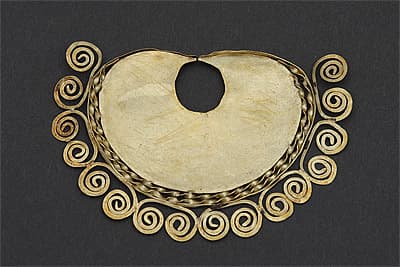
SICÁN-LAMBAYEQUE culture North coast 750 – 1375 AD
Nose ornament 900-1100 AD gold , rolling, filigree, soldering6.0 (h) x 4.0 (w) cm Ministerio de Cultura del Perú: Museo Arqueológico Nacional Brüning, Lambayeque Photograph: Daniel Giannoni
Filigree gold wire frames the outer edge of this nose ornament’s strikingly simple gold half-moon body. The central area is ringed with two parallel bands of twisted gold, similar to those found on jewellery at the Frías Valley grave sites (see cats 16, 17). Around the rim of the nose ornament, eight distinct double spirals of gold wire have been twisted and then delicately soldered to the outer of three twisted additional bands of wire. The double spiral probably represents the eyes of an owl, symbol of warriors in the Moche tradition (cat. 61).
The filigree technique appeared around 600 BC on the north coast of Peru and the coast of Ecuador.1 It was an important decorative element on goldwork in the Frías style, as well as on the gold objects produced by the Moche culture, which dominated from 100 AD. The Sicán-Lambayeque culture, which rose in the same area after the Moche decline, continued the strong tradition of northern Peruvian metalwork. Other decorative elements found on Sicán-Lambayeque jewellery, such as beading and discs, appear to correspond with metalwork produced by other northern Andean societies.2
Simeran Maxwell
1. Luisa María Vetter in L’or des Incas: Origines et mystères, Paris: Pinacothèque de Paris 2010, p. 201.
2. Gabriela Schwörbel Hoessel, ‘The forgers of metal’, in Victoria Mujica (ed.), Oro del Peru Museum, Lima: Fundación Miguel Mujica Gallo 2009, p. 169.
Filigree gold wire frames the outer edge of this nose ornament’s strikingly simple gold half-moon body. The central area is ringed with two parallel bands of twisted gold, similar to those found on jewellery at the Frías Valley grave sites (see cats 16, 17). Around the rim of the nose ornament, eight distinct double spirals of gold wire have been twisted and then delicately soldered to the outer of three twisted additional bands of wire. The double spiral probably represents the eyes of an owl, symbol of warriors in the Moche tradition (cat. 61).
The filigree technique appeared around 600 BC on the north coast of Peru and the coast of Ecuador.1 It was an important decorative element on goldwork in the Frías style, as well as on the gold objects produced by the Moche culture, which dominated from 100 AD. The Sicán-Lambayeque culture, which rose in the same area after the Moche decline, continued the strong tradition of northern Peruvian metalwork. Other decorative elements found on Sicán-Lambayeque jewellery, such as beading and discs, appear to correspond with metalwork produced by other northern Andean societies.2
Simeran Maxwell
1. Luisa María Vetter in L’or des Incas: Origines et mystères, Paris: Pinacothèque de Paris 2010, p. 201.
2. Gabriela Schwörbel Hoessel, ‘The forgers of metal’, in Victoria Mujica (ed.), Oro del Peru Museum, Lima: Fundación Miguel Mujica Gallo 2009, p. 169.
Filigree gold wire frames the outer edge of this nose ornament’s strikingly simple gold half-moon body. The central area is ringed with two parallel bands of twisted gold, similar to those found on jewellery at the Frías Valley grave sites (see cats 16, 17). Around the rim of the nose ornament, eight distinct double spirals of gold wire have been twisted and then delicately soldered to the outer of three twisted additional bands of wire. The double spiral probably represents the eyes of an owl, symbol of warriors in the Moche tradition (cat. 61).
The filigree technique appeared around 600 BC on the north coast of Peru and the coast of Ecuador.1 It was an important decorative element on goldwork in the Frías style, as well as on the gold objects produced by the Moche culture, which dominated from 100 AD. The Sicán-Lambayeque culture, which rose in the same area after the Moche decline, continued the strong tradition of northern Peruvian metalwork. Other decorative elements found on Sicán-Lambayeque jewellery, such as beading and discs, appear to correspond with metalwork produced by other northern Andean societies.2
Simeran Maxwell
1. Luisa María Vetter in L’or des Incas: Origines et mystères, Paris: Pinacothèque de Paris 2010, p. 201.
2. Gabriela Schwörbel Hoessel, ‘The forgers of metal’, in Victoria Mujica (ed.), Oro del Peru Museum, Lima: Fundación Miguel Mujica Gallo 2009, p. 169.

